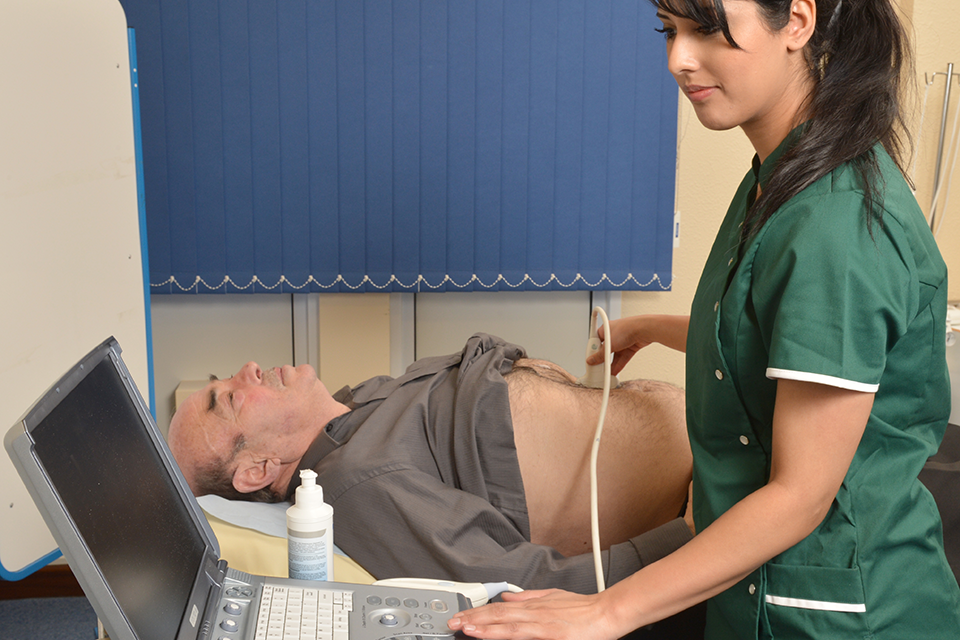AAA screening: information for health professionals
Updated 24 June 2019
The NHS Abdominal Aortic Aneurysm (AAA) Screening Programme was implemented throughout England between 2009 and 2013.
Research shows that offering men ultrasound screening in their 65th year should reduce the rate of premature death from ruptured AAA by up to 50%.
1. Structure and delivery
The NHS AAA Screening Programme is coordinated and led nationally by Public Health England. Screening services are delivered locally in line with national quality standards and protocols.
There are 38 local screening services covering the whole of England.
Each local service co-ordinates screening for the population in its area and organises invitation letters, screening and surveillance clinics, results letters and referrals to the appropriate vascular network.
Local screening providers inform GPs when men from their practice have been screened and of the outcomes of their screening test.
2. Prevalence
There are around 3,000 deaths each year in men aged 65 and over in England and Wales from ruptured AAA.
Deaths from ruptured AAA account for 1.7% of all deaths in men aged 65 and over.
Around 1 in 70 men aged 65 in England has an AAA.

Drawing of a man's torso, showing chest, heart, normal abdominal aorta and abdomen next to another drawing of a man's torso, showing chest, heart, abdominal aorta with an aneurysm and abdomen
3. Risk factors
The main risk factors are age and being male. Two out of every 3 deaths from ruptured AAA in England and Wales occur in men who are over 65.
The condition is 6 times more common in men than women.
Risk is increased by smoking, high blood pressure or through close family history.
4. The screening process
Men are automatically invited for screening in the year they turn 65.
Men who are older than 65, and who have not previously been screened, can opt in through self-referral direct to the screening programme.
Men who have previously been treated for an abdominal aortic aneurysm are excluded from screening.
Men receive an invitation leaflet with an appointment 3 to 6 weeks in advance.
If a man accepts the invitation, an ultrasound scan of the abdomen is carried out and the aortic diameter measured.

Photo of a screening technician performing an ultrasound scan test on a man who is lying down with his abdomen exposed
Men receive their screening results verbally immediately after the scan and in the post shortly afterward if an aneurysm is found. All results are provided by post to the GP.
5. Possible results
5.1 No aneurysm found (985 of 1,000 men screened)
Aortic diameter less than 3cm.
Follow-up
No treatment or further scans required. Man discharged from screening programme.
Primary care
GP informed of result by letter.
5.2 Small or medium aneurysm (14 of 1,000 men screened)
Aortic diameter measures:
- 3 to 4.4cm (small aneurysm)
- 4.5 to 5.4cm (medium aneurysm)
Follow-up
Man offered yearly surveillance (small aneurysm) or 3-monthly surveillance (medium aneurysm).
Appointment with nurse practitioner / vascular nurse offered at or before first surveillance scan.
Primary care
GP informed, by letter, of the outcomes of screening and appointment with nurse.
Review and prescribing of medication may be appropriate.
Individual may require regular blood-pressure monitoring.
Steps individual can take which may slow growth of the aneurysm include:
- eating a healthy balanced diet and reducing intake of fatty foods
- stopping smoking
- maintaining a healthy weight
- taking regular exercise
5.3 Large aneurysm (1 in 1,000 men screened)
Aortic diameter 5.5cm or above.
Follow-up
Individual referred to consultant vascular surgeon within defined and agreed vascular network by manager/coordinator of local screening service.
Primary care
GP informed by phone call or fax, and then by letter.
Steps individual can take in advance of potential treatment include:
- eating a healthy balanced diet and reducing intake of fatty foods
- stopping smoking
- maintaining a healthy weight
5.4 Non-visualised
Repeat scan required.
Follow-up
Individual offered appointment at hospital medical imaging department.
Primary care
GP informed by letter.
